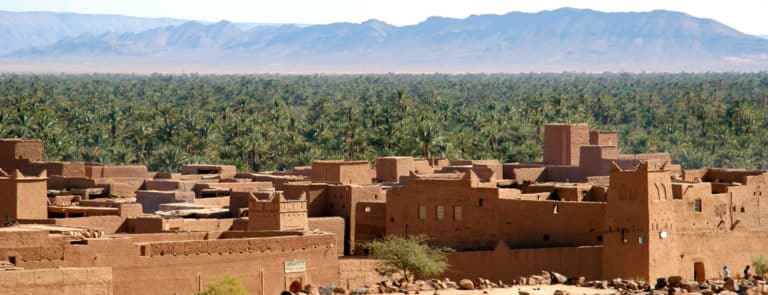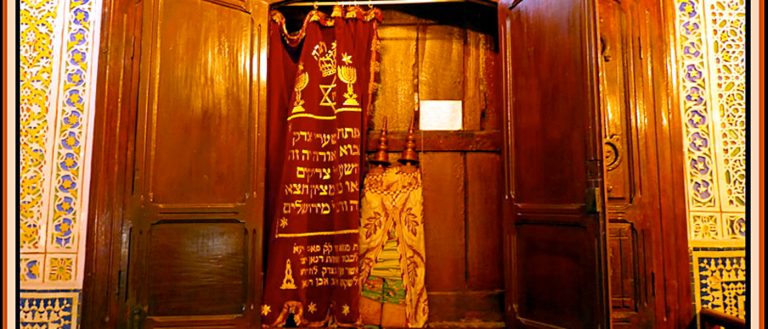Your 15-day tour of Morocco starts with your arrival in Casablanca, the largest and most cosmopolitan city in Morocco. You will be greeted and transferred to Casablanca.
Today, we suggest lunch at the famous Rick’s café (at leisure). Start your private tour of Casablanca in the afternoon, and visit the magnificent Hassan II Mosque, Morocco’s only functioning mosque open to non-Muslims. Then go to the central market, the Habous district, and Mohammed V square, where you will witness the famous art deco left by the French (the new Medina).
Later this afternoon, continue to Rabat.
Overnight at your hotel.
After breakfast, start visiting Rabat, one of Morocco’s four ancient capitals, or imperial cities. As we discover on this morning tour, Rabat is again the country’s capital, at once historical and contemporary.
We visit the fortified Kasbah of the Oudaias, the peaceful Andalusian Gardens, the museum of Moroccan arts and the late king Mohammed V’s mausoleum and the outside of the royal palace.
Lunch at leisure before we continue to Fez, the spiritual capital of Morocco.
Overnight at your riad or hotel.
Today we explore Morocco’s oldest imperial city, considered the “Athens of Africa” for its wealth of cultural, educational, and religious institutions.
We begin with a walking tour of Fez’s fascinating Medina, a UNESCO World Heritage site, focusing on the artisans’ quarters, the 14th-century Koranic schools, and Al Karaouine, the medieval theological university, and then to the potter’s district.
As you might all know, the best Moroccan meal is always cooked at home. For that reason, a traditional Moroccan family will invite us for lunch today at their traditional Moroccan house in the heart of the Medina.
In the afternoon, tour the old Mellah (Jewish quarter), its 17th-century synagogue, the royal gates, and the Museum of Fez.
Overnight at your riad or hotel.
Departure from Fez at around 10 am for a 1 hour’s drive west to the Imperial city of Meknes.
Driving across the plain, you will see vast acreages of vineyards which produce good quality wine, much of which is exported to France. Moulay Ismail made Meknes the capital of Morocco during his reign around 1700; his mausoleum and the Rouah, his stables for over 12,000 horses, and Place el-Hedim, the central pedestrian square in the Medina, are well worth a visit.
After lunch (at leisure), our journey takes you 30 km north to the hillside settlement of Moulay Idriss. The town is one of the country’s most important spiritual sites and a place of pilgrimage as it is the site of the tomb of Moulay Idriss, a prominent saint in the late 8th century and a great-grandson of the prophet Mohammed.
A guided tour of the Volubilis site. Leaving Moulay Idriss for the short 4 km drive to the World Heritage Site of Volubilis, there are several vantage points to take photographs of the town. Volubilis is the site of the largest and best preserved Roman ruins in Morocco, particularly noted for its superb mosaic floors; it has fabulous views of the Rif Mountain foothills, particularly at sunset.
Overnight at your riad.
Travelling inland today, we cross the fertile plains beyond Fez and continue through the Middle Atlas mountain range.
We stop in the small town of Midelt for lunch (at leisure). Continuing, we cross the Ziz River, passing rows of sky-scraping palm trees and fortified villages before reaching our kasbah-style hotel in Erfoud late in the day. Then you switch to 4×4 jeeps to cross the Erg Chebbi dunes to your luxury Sahara desert camp.
Arrive just before sunset, switch into camels for a ride over the hills of Erg Chebbi, and watch a dramatic colour-changing sunset.
Dinner will be served under the stars next to the fire camp.
Our destination today is in the snow-topped High Atlas.
The day features one beautiful scene after another, including the village of Tineghir, a stunning mountain oasis rising on a series of riverside terraces lush with palm trees; and the spectacular 984-foot Todra Gorge, home to a variety of rare bird and plant species.
Before lunch, walk through the oasis and watch ladies doing traditional farming work or washing clothes at the river bank. Following lunch at Chez Michele restaurant, owned by a French lady who fell in love with the region and started her guest house business next to the Todgha river, we continue to Boumalne Dades.
Dinner and overnight at your hotel.
This morning, we continue to Kelaa Megouna, known for growing Damascus roses in perfumery.
Visit a perfumery ladies cooperative and learn how to make different cosmetic products off rose petals. Then set out on the fabled “Route of a Thousand Kasbahs”, an ancient caravan route with a region of fortresses with elaborately decorated façades. Late morning, we reach Ouarzazate, the gate to the Sahara. We will visit Kasbah Taourirt before we continue to the world heritage site of Kasbah Ait Ben Hadou, one of southern Morocco’s most scenic villages that are often used as a location for fashion and film shoots. Its old section consists of deep red kasbahs packed together so tightly they appear to be a single unit.
After lunch (at leisure), we continue to Marrakech. As we descend from the High Atlas, we pass through typical villages with fortified walls and stone houses with earthen roofs. In Tizi N’Tichka, we traverse the Pass of the Pastures (alt. 7,415 feet), where life is much as it was centuries ago: shepherds bring their flocks to the high pastures every summer, then return with them to their villages in autumn. We arrive in Marrakech late this afternoon.
Overnight at your riad or hotel.
Once the capital of southern Morocco, the imperial city of Marrakech is an alluring oasis with a temperate climate, distinct charm, and fascinating sights.
Our day-long tour includes the beautifully proportioned Koutoubia Mosque with its distinctive 282-foot minaret visible from miles away, the beautiful Andalusian-style El Bahia Palace (part of which is still used by the royal family), and the Palace of Dar Si Said, a museum housing Moroccan art and artefacts.
Mid-afternoon, we embark on a walking tour of the Medina, ending at Djemaa el Fna Square, a UNESCO site and the heart of Marrakech, crowded with snake charmers, entertainers, storytellers, musicians, barbers, and sellers of fruit, water, and spices.
Overnight at your riad or hotel.
This morning, you’ll learn how to cook a Tangia in a riad in the heart of the Medina; Tangia is a famous dish in Marrakech.
Start with a tour of the Souks where you’ll do your ingredients shopping yourselves with your guide: vegetables, meat and spices. At the end of the course, follow your guide to the «Fernatchi», a traditional baker, and leave your Tangia pot to be cooked in a traditional oven. Come back to your riad and learn how to make some traditional Moroccan salads while waiting for the Tangia.
In the afternoon, you complete the discovery of Marrakech city on a horse and cart by visiting the private collection of Mr Bert Flint, a Dutch anthropologist. He studied the Berber cultural heritage, representing the Berber and Subsaharan artistic cultures. Then on to the private museum of Mr Yves Saint Laurent, offering one of the most exciting collections of Eves Saint Laurent, as well as the Majorelle gardens, designed in the ’20s by the famous french artist Jacques Majorelle.
Optional oriental spa experience this afternoon at Les Bains de Marrakech, one of the best Spas in Morocco.
Overnight at your riad or hotel.
Spend the day at leisure in Marrakech, or ask us for activities in and around the city.
Leave Marrakech to Essaouira, the former Mogador, once a Phoenician trading post dating back to 814 BC. Arrival at lunchtime (on own) and afternoon visit to the city.
Under Roman occupancy, Essaouira became famous for its production of «Purple dye» coming from the Murex shellfish. In the 16th century, the Portuguese sailors renamed Mogador, which became an important trading centre. In 1764 the sultan Mohamed ben Abdellah will call upon the French architect Théodore Cornut – a disciple of Vauban – to build a new city, which he did, and Essaouira deserves her name, meaning «the well-drawn».
The city was very wealthy until the second half of the 19th century, mainly due to a large Jewish community (up to 17.000 against only 10.000 Moslems!). But most of them left after the Six days war. After a decline of its fishing harbour – as the sardines shoals were drifting far more south – the city is born and alive again, mainly through culture (handicraft of Marquetry, painting, music festivals) and Tourism.
Dinner and overnight at your hotel.
Spend the day at leisure in Essaouira.
Morning departure to Safi, fishing harbour on the Ocean and centre of a very famous Pottery tradition. Visit the city and the potters quarter.
Then on to Oualidia, a holiday seaside resort on a lagoon famous for its oyster breeding and seafood restaurants. Lunch stop (on own). After a late lunch, onto El Jadida by a superb road bordering the Atlantic ocean.
Check-in at your hotel: dinner and overnight.
After breakfast, meet your guide for a visit to the nearby towns of Azemmour and El Jadida.
The charm of the towns of Azemmour and Le Jadida comes from their fortified Medians. Their narrow streets, beautiful buildings and gates combine Portuguese, Arab, Andalusian and Berber architectural styles. Your tour begins with a short drive from your hotel to Azemmour.
Stop at the entrance of the town for a panoramic view of this white-washed town on the banks of the Oum Rabiaa River, then to one of Azemmour’s main gates: Sidi Makhfi, named after one of the town’s Sophism figures.
Walk through the Medina and stop for a panoramic view of the port and the Atlantic Ocean. Walk through the Kasbah to reach a large square overlooking the river. Close to it, a Synagogue is still a witness to the coexistence between the native inhabitants and the Jewish community. From here, continue to the Portuguese town of Mazagan, later named El Jadida (meaning The New One) by the Arabs. Visit the cistern built by the Portuguese settlers to serve as a water reservoir during the prolonged siege.
Spend the afternoon at leisure. Dinner and overnight at your hotel.
Spend the day at leisure in your hotel before transferring to Casablanca airport for your return flight.








